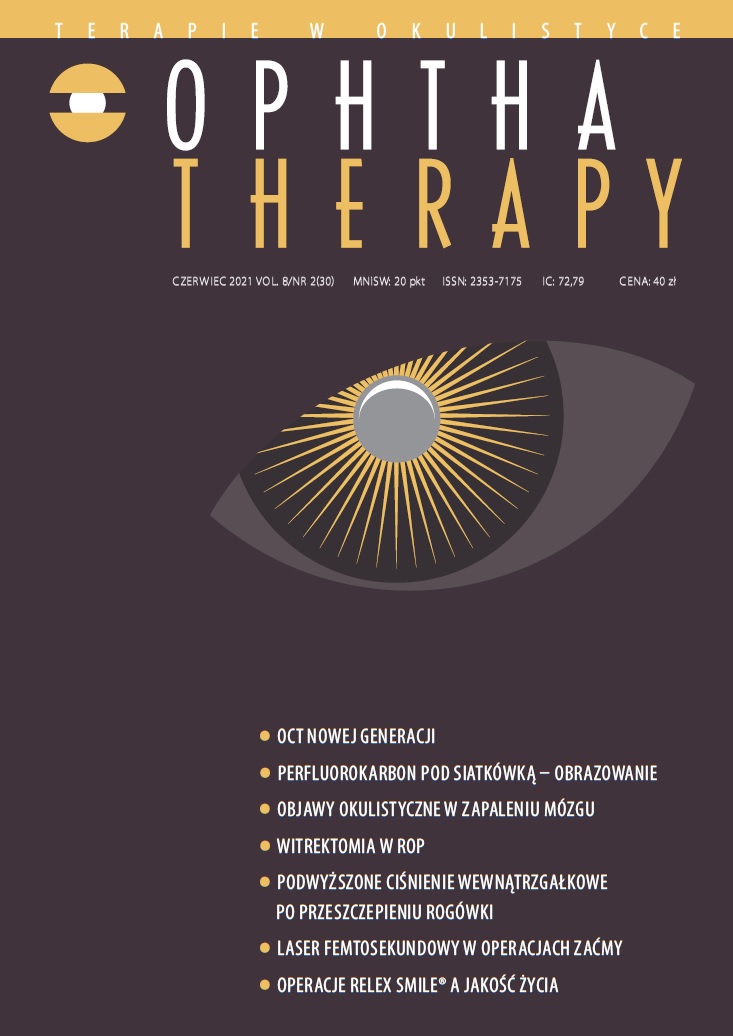The application of the femtosecond laser in cataract surgery Review article
Main Article Content
Abstract
Introduction: Since the introduction, femtosecond laser-assisted cataract surgery (FLACS) was believed to revolutionize cataract surgery. However, the judgment of clinical benefits was found to be far more complex than initially might have been thought. The aim of this review was to analyze the benefits and drawbacks of FLACS compared to traditional phacoemulsification cataract surgery.
Results: The benefits of FLACS include lower cumulated phacoemulsification time and endothelial cell loss, perfect centration of the capsulotomy, and the possibility to perform precise femtosecond-assisted arcuate keratotomy incisions. The major disadvantages of FLACS are: high cost of the laser and the disposables for surgery, FLACS-specific intraoperative capsular complications, as well as the risk of intraoperative miosis and the learning curve.
Conclusions: FLACS seems to be beneficial in some groups of patients i.e., with low baseline endothelial cell count, or those planning to receive multifocal intraocular lenses. Nevertheless, having considered that the advantages of FLACS might not be clear in every routine case, it cannot be considered as cost-effective.
Downloads
Article Details

This work is licensed under a Creative Commons Attribution-NonCommercial-NoDerivatives 4.0 International License.
Copyright: © Medical Education sp. z o.o. License allowing third parties to copy and redistribute the material in any medium or format and to remix, transform, and build upon the material, provided the original work is properly cited and states its license.
Address reprint requests to: Medical Education, Marcin Kuźma (marcin.kuzma@mededu.pl)
References
2. Feldman BH. Femtosecond laser will not be a standard method for cataract extraction ten years from now. Surv Ophthalmol. 2015; 60(4): 360-5. https://doi.org/10.1016/j.survophthal.2015.02.002.
3. Zhang X, Yu Y, Zhang G et al. Performance of femtosecond laser-assisted cataract surgery in Chinese patients with cataract: a prospective, multicenter, registry study. BMC Ophthalmol. 2019; 19(1): 77.
4. Alió JL, Abdou AA, Soria F et al. Femtosecond laser cataract incision morphology and corneal higher-order aberration analysis. J Refract Surg. 2013; 29(9): 590-5.
5. Mayer WJ, Klaproth OK, Hengerer FH et al. In vitro immunohistochemical and morphological observations of penetrating corneal incisions created by a femtosecond laser used for assisted intraocular lens surgery. J Cataract Refract Surg. 2014; 40(4): 632-8.
6. Rodrigues R, Dos Santos MS, Silver RE et al. Corneal incision architecture: VICTUS femtosecond laser vs manual keratome. Clin Ophthalmol. 2019; 13: 147-152. https://doi.org/10.2147/opth.s181144.
7. Chan TCY, Cheng GPM, Wang Z et al. Vector Analysis of Corneal Astigmatism After Combined Femtosecond-Assisted Phacoemulsification and Arcuate Keratotomy. Am J Ophthalmol. 2015; 160(2): 250-5.e2. https://doi.org/10.1016/j.ajo.2015.05.004.
8. Panthier C, Costantini F, Rigal-Sastourné JC et al. Change of Capsulotomy Over 1 Year in Femtosecond Laser-Assisted Cataract Surgery and Its Impact on Visual Quality. J Refract Surg. 2017; 33(1): 44-9.
9. Daya S, Chee S-P, Ti S-E et al. Comparison of anterior capsulotomy techniques: continuous curvilinear capsulorhexis, femtosecond laser-assisted capsulotomy and selective laser capsulotomy. Br J Ophthalmol. 2020; 104(3): 437-42.
10. Abell RG, Darian-Smith E, Kan JB et al. Femtosecond laser-assisted cataract surgery versus standard phacoemulsification cataract surgery: Outcomes and safety in more than 4000 cases at a single center. J Cataract Refr Surg. 2015; 41(1): 47-52. https://doi.org/10.1016/j.jcrs.2014.06.025.
11. Conrad-Hengerer I, Hengerer FH, Joachim SC et al. Femtosecond laser–assisted cataract surgery in intumescent white cataracts. J Cataract Refract Surg. 2014; 40(1): 44-50. https://doi.org/10.1016/j.jcrs.2013.08.044.
12. Zhu Y, Chen X, Chen P et al. Lens capsule-related complications of femtosecond laser–assisted capsulotomy versus manual capsulorhexis for white cataracts. J Cataract Refract Surg. 2019; 45(3): 337-42. https://doi.org/10.1016/j.jcrs.2018.10.037.
13. Abell RG, Kerr NM, Vote BJ. Toward Zero Effective Phacoemulsification Time Using Femtosecond Laser Pretreatment. Ophthalmology. 2013; 120(5): 942-8. https://doi.org/10.1016/j.ophtha.2012.11.045.
14. Kanclerz P, Alio JL. The benefits and drawbacks of femtosecond laser-assisted cataract surgery. Eur J Ophthalmol. 2020. Online ahead of print. https://doi.org/10.1177/1120672120922448.
15. Piňero A, Kanclerz P, Barraquer RI et al. Evaluation of femtosecond laser-assisted cataract surgery after 10 years of clinical application. Arch Soc Esp Oftalmol. 2020; 95(11): 528-37.
16. Nagy ZZ, Takacs AI, Filkorn T et al. Complications of femtosecond laser-assisted cataract surgery. J Cataract Refract Surg. 2014; 40(1): 20-8.
17. Jun JH, Hwang KY, Chang SD et al. Pupil-size alterations induced by photodisruption during femtosecond laser-assisted cataract surgery. J Cataract Refract Surg. 2015; 41(2): 278-85.
18. Walter K, Delwadia N, Coben J. Continuous intracameral phenylephrine-ketorolac irrigation for miosis prevention in femtosecond laser-assisted cataract surgery: Reduction in surgical time and iris manipulation. J Cataract Refract Surg. 2019; 45(4): 465-9. https://doi.org/10.1016/j.jcrs.2018.11.004.
19. Grzybowski A, Kanclerz P. The Role of Steroids and NSAIDs in Prevention and Treatment of Postsurgical Cystoid Macular Edema. Curr Pharm Des. 2018; 24(41): 4896-902.
20. Ewe SYP, Oakley CL, Abell RG et al. Cystoid macular edema after femtosecond laser-assisted versus phacoemulsification cataract surgery. J Cataract Refract Surg. 2015; 41(11): 2373-8. https://doi.org/10.1016/j.jcrs.2015.04.031.
21. Day AC, Gore DM, Bunce C et al. Laser-assisted cataract surgery versus standard ultrasound phacoemulsification cataract surgery. Cochrane Database Syst Rev. 2016. https://doi.org/10.1002/14651858.cd010735.pub2.
22. Mayer WJ, Klaproth OK, Ostovic M et al. Cell Death and Ultrastructural Morphology of Femtosecond Laser-Assisted Anterior Capsulotomy. Invest Ophthalmol Vis Sci. 2014; 55(2): 893. https://doi.org/10.1167/iovs.13-13343.
23. Sun W, Liu J, Li J et al. Human lens epithelial cell apoptosis and epithelial to mesenchymal transition in femtosecond laser-assisted cataract surgery. Int J Ophthalmol. 2018; 11(3): 401-7.
24. Pisciotta A, De Maria M, Verdina T et al. Anterior Capsule of the Lens: Comparison of Morphological Properties and Apoptosis Induction following FLACS and Standard Phacoemulsification Surgery. Biomed Res Int. 2018; 2018: 7242837.
25. Manning S, Barry P, Henry Y et al. Femtosecond laser-assisted cataract surgery versus standard phacoemulsification cataract surgery: Study from the European Registry of Quality Outcomes for Cataract and Refractive Surgery. J Cataract Refract Surg. 2016; 42(12): 1779-90. https://doi.org/10.1016/j.jcrs.2016.10.013.
26. Abell RG, Vote BJ. Cost-effectiveness of femtosecond laser-assisted cataract surgery versus phacoemulsification cataract surgery. Ophthalmology. 2014; 121(1): 10-6.

